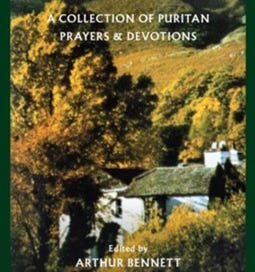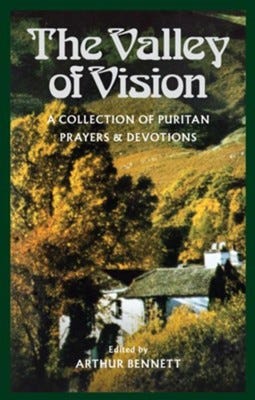Sourcing 'The Valley of Vision': Prospectus
"I live in the depths but see thee in the heights…"
What Is The Valley of Vision, and Where Did It Come From?
In 1975, the Banner of Truth Trust published a book entitled The Valley of Vision: A Collection of Puritan Poems and Devotions, edited by an Anglican churchman named Arthur Bennett. The book has gone on to be quite popular in certain Christian circles—particularly those, not surprisingly, that value and draw from the Puritan tradition. An article by Justin Taylor at The Gospel Coalition provides an overview of the book, its editor, and its influence—important background information that I won’t bother to duplicate here. Suffice it to say, The Valley of Vision is an influential book, one that has shaped and will continue to shape the spiritual lives of many devoted Christians.
Taylor does, however, raise and answer one important question that should spark curiosity, at least among the obsessively bookish:
Are there sources in the book indicating where the prayers are from?
No, not for the individual prayers. All we know for certain is that Bennett composed the first prayer himself. Bennett tells us the authors and books he is quoting, but they are not keyed to the actual prayers.
Again, the book’s subtitle makes the claim that it is “a collection of Puritan poems and devotions.” Where, then, do the contents of The Valley of Vision come from?
Bennett gives us some insight into his compilation process in his preface, in which he clarifies that the book’s entries are “drawn from the largely forgotten deposit of Puritan spiritual exercises, meditations and aspirations,” and that their presence in the volume has been the result of his “extracting this selection from Puritan literature,” adapting it along the way to suit the needs of private devotion—for example, by “chang[ing] some prayers from the plural and the third person into the singular and the first person,” or by “refram[ing] some phrases in order to accommodate archaic thought to modern understanding.”
The preface also contains a list of men from whose works Bennett’s prayers were “taken”—some of whom can indeed be described as Puritans, while others (e.g., Spurgeon) are probably better described as inheritors of the Puritans’ theological legacy. The bibliography at the back of the book lists some particular works by each. These include (in the order listed in the preface):
Thomas Shepard (Works, vol. 3)
Thomas Watson (The Lord’s Prayer)
Richard Baxter (The Saint’s Rest)
John Bunyan (Grace Abounding)
Isaac Watts (Works, vol. 3)
William Williams (Y Caniedydd Cynelleidfoal Newydd)
Philip Doddridge (The Rise and Progress of Religion in the Soul)
William Romaine (The Walk of Faith)
David Brainerd (Diary, Journal and Letters)
Augustus Toplady1 (Works, vol. 1)
Christmas Evans (Life of Christmas Evans)
William Jay (Prayers for the Use of Families)
Henry Law (Family Prayers)
Charles Haddon Spurgeon (The Pastor in Prayer)
Finally, the bibliography contains the helpful clarification that “the Editor is responsible for the titles, ascriptions, and structure of the prayers in this present volume, and for the introductory prayer, ‘The Valley of Vision.’”
All well and good. But this still leaves us facing a bit of a problem. We know that Bennett claimed sole authorship only of the first entry in the collection; and we know that for the rest, he adapted his (rather voluminous) sources but did not clarify which ones belonged to which prayers. This makes it difficult to answer a simple question that a reasonable reader might ask of any entry: Where exactly can I find and read the original passage in the original work that this prayer was based on?
This is a problem I’d like to help solve.
Wait, Who Are You?
Hi. My name is Adam Marshall. I was almost an academic once (long story). I actually wrote my MA thesis at Baylor University on a set of prayers—namely, the ones in John Donne’s Devotions upon Emergent Occasions2—and I considered writing about George Herbert, the great seventeenth-century British devotional poet, for my (abortive) PhD before I jumped ship on the early modern period became a now-erstwhile medievalist.3
But that’s all beside the point. Nowadays, I work full-time as the production editor for a non-profit Bible teaching ministry. In that role, one of my responsibilities is to oversee the editing of transcripts of our audio lessons—and one aspect of that responsibility is to source and cite quotations within those lessons.
Over the years of my involvement with this project, I’ve developed at least these four things: (1) a strong conviction that Christian preachers and teachers ought to give proper attribution to their sources, always; (2) a keen appreciation for the times when they do; (3) a very particular set of skills for helping out when they don’t; and (4) a sense of either skepticism or curiosity (depending on the state of my soul at the moment) whenever I hear something “quoted” in a sermon.
So, obviously, when my own pastor started quoting from The Valley of Vision on the occasional Sunday morning, I was intrigued, and became all the more so when I discovered the background outlined above.
And so I started digging.
What Have I Done, What Do I Want to Do, and Why?
Armed as I was with Bennett’s (possibly incomplete) list of sources, an editor’s sense of a fellow editor’s process, and a power user’s arsenal of search methods, I started poking around to see if I could suss out the sources for a few of Bennett’s prayer-poems—and lo and behold, I could… not in every case, but definitely in several.
Doing so, though, proved more difficult than Bennett’s summary might have suggested. For some prayers, his alterations of his sources went beyond merely changing pronouns or updating idioms—not, mind you, in any irresponsible ways that I’ve yet observed, but enough to make establishing easy one-to-one relationships between sources and prayers at least a challenge.
Before I proceeded further, then, I reached out via email to the general manager at Banner of Truth, who confirmed for me that (1) the prayers contained in the Valley of Vision aren’t direct reproductions but rather adaptations, to varying degrees, of Bennett’s sources (no surprises there at this point); and (2) there is no record of what text(s), exactly, each prayer was adapted from. Per his response, while Banner does have “some editorial records that relate to it, … there isn’t any kind of comprehensive listing. At this point, bearing in mind that it is about 50 years since the work was done, I doubt that there is enough to reconstruct a record.”
What I propose to do here, then, in this Substack, is, simply put, to source The Valley of Vision, one prayer at a time, at something around the rate of one per week.4
Why? Well, for starters, it’s work that’s not been done yet, to my knowledge, and it’s work that I feel reasonably competent to at least start. (I have no doubt that I will hit dead ends—I already have—where others will have to come behind and pick up where I gave up.) I would do it faster, even, but… well, you know, life: job to do, kids to raise, church to serve, neighbors to visit, books to read, etc., etc.
Still, my hope is that by beginning to identify the sources of Bennett’s prayer adaptations, a few goods can be achieved:
Curious readers will know where to go to encounter the originals, in their original settings and language, and will perhaps be encouraged to explore those writings further.
Interested scholars will be able to more easily investigate the methods Bennett used for adapting The Valley of Vision’s prayers, as well as what those adaptations may suggest about the act of adaptation itself, the nature of Christian devotional literature, and the legacy of the Puritan tradition.
Devoted Christian pastors, preachers, leaders, teachers, and laypeople will be able to read The Valley of Vision and use it as an aid to worship with greater confidence that it is (at least I hope to discover) faithfully rooted in a time-tested theological tradition.
Bennett’s legacy as a contributor to the Christian devotional experience will be strengthened and further legitimatized by the availability of a full, direct, and clear understanding of his source-texts.
Maybe some hapless graduate student in search of a project will be able to pick up wherever I leave off, further fill in the gaps, and earn themselves their MTS.5
If there are concerns I have with the project, they’re really three:
Will anyone care?
Will I stick with it? (heavily dependent on #1)
Will I keep finding what I’m looking for?
If you’ve read this far and this is a project you think you’d like to support, then you can help me out with #1 above by subscribing to this Substack.6 Knowing there’s someone, anyone, out there interested in my findings, whatever they are, will do a good bit to keep me motivated. And really, who knows what fascinating discoveries this project may turn up? Maybe none! But at the very least, we can spend some time thinking about prayers and poetry together—and that’s certainly not a bad way to spend some time, right?
I’ll try to check back in around this time next week with the first round of findings. Till then, wish me happy hunting!
Still among the funniest names in Christendom. And his middle name’s Montague to boot!
It was fine.
Based on the number of prayers in The Valley of Vision, this should take just shy of four years. So settle in and get comfy!
Or at least a begrudging high-five from their advisor.
That’s a thing you do to Substacks, right?





Sounds like a great time Adam. Excited to see what comes of this.